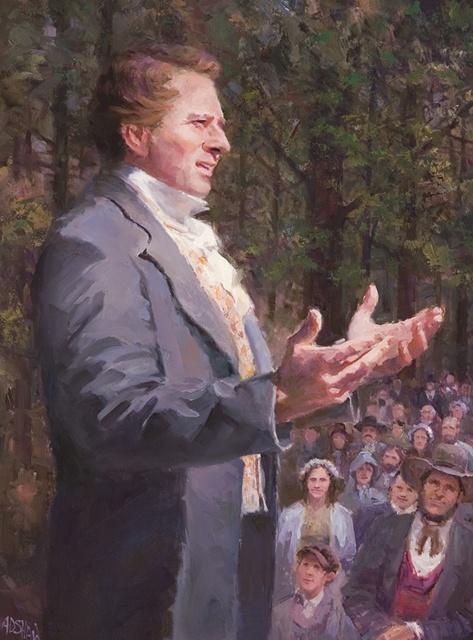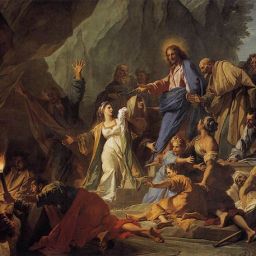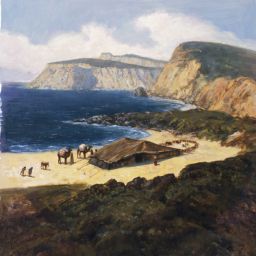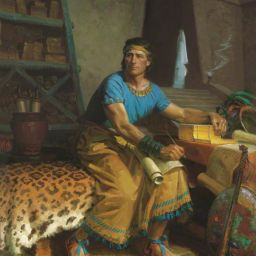An Explanation
When examining Book of Mormon evidences, we take note of the use of obscure names, Hebrew syntax, location names, poetic patterns, and more. All these things provide some evidence that the Book of Mormon has an ancient source. But, of course, we could ask: “Couldn’t Joseph Smith have just been a genius who researched all that and put it in deliberately?”
But if we accept that idea as true, we must then logically follow it to the conclusion: If Joseph was getting correct information from outside sources, wouldn’t he have also gotten incorrect information from those same sources when they were wrong?
As a specific example, some people suggest Joseph relied on “View of the Hebrews,” a contemporary text which suggested that all Native Americans were “Jews,” and thus has several natural parallels with the Book of Mormon. But if we accept this as true, and “View of the Hebrews” was relied on for information, how do we explain all the things in that text which Joseph failed to use in his alleged creation of the Book of Mormon? For example, “View of the Hebrews” claims that Native Americans carried an ark into battle, that they called God “Yohewah,” that they don’t worship multiple gods or any idols, and so on. “View of the Hebrews” got much wrong about Native Americans. How did Joseph manage to avoid falling into the same trap if he was really using it as a resource, or drawing from the same data that Ethan Smith used? (Smith E. , 1823)
Just a few examples of the many things Joseph got right, but should have got wrong.
ILLITERATE NATIVES – Joseph’s contemporaries believed in an illiterate population of Native Americans and some mocked him for missing such a well-known fact. (Stevenson, 1839) Only later was writing systems discovered dating back to the time of the Jaredites. (Coe & Houston, 2015) Why risk having your made-up “Lehites” be readers when it’s common knowledge that Native Americans don’t read?
 BASIC BIBLE STUDY GONE WRONG – Joseph was intensely mocked for including the birth of Jesus as taking place in “the Land of Jerusalem” rather than Bethlehem. How could he have missed such an obvious and essential point as a member of a very Christian community? (Bacheler, 1838) 70 years later the Amarna letters – tablets dating to a few hundred years before Lehi – are discovered and they reveal that indeed, Bethlehem was considered part of the “Land of Jerusalem.” (Nibley, Lehi in the Desert, 1988)
BASIC BIBLE STUDY GONE WRONG – Joseph was intensely mocked for including the birth of Jesus as taking place in “the Land of Jerusalem” rather than Bethlehem. How could he have missed such an obvious and essential point as a member of a very Christian community? (Bacheler, 1838) 70 years later the Amarna letters – tablets dating to a few hundred years before Lehi – are discovered and they reveal that indeed, Bethlehem was considered part of the “Land of Jerusalem.” (Nibley, Lehi in the Desert, 1988)
ARABIAN RESOURCES – Had Joseph done research on the Arabian Peninsula, he likely would have found the most up-to-date and scholarly work of the time described the entire coastline as “a rocky wall … as dismal and barren as can be; not a blade of grass or a green thing.” (Conder, 1830) And that “There is very little timber in Arabia of any kind.” (Dwight, 1805) Yet the Book of Mormon describes locations which are lush paradises with fresh water, wood suitable for boat building, bow making, and food to support a large family, which is what we find today.
MILLIONS OF PEOPLE? – Early critics pointed out that nobody had ever heard of hundreds of thousands, much less millions of Native Americans in a single nation. (Parsons, 1842) They were known to be a small population in Joseph’s day, yet the Book of Mormon describes populations comparable to Rome or other ancient capitals at its height. Joseph would have been even more embarrassed if he would have had to explain a story about a tiny population when we’ve discovered the remains of cities with populations in the millions in the right time frame and probable locations as described in the Book of Mormon. (Clynes, 2018)
STEEL SHOULD HAVE BEEN EASY TO GET “RIGHT.” – To even the layman of the early 1800s, it was a notorious fact that steel is a modern invention. (Howe, 1834) A scholar or layperson creating the Book of Mormon should have never used the word. Yet Joseph did. Once again time bore out the claim of the Book of Mormon as steeled swords have been discovered dating back not only to Lehi’s day, but to his geographic area. (Muhly, 1982)
WAIT… IS THIS BOOK GETTING MORE TRUTHY AS TIME PASSES? – Recently, some researchers compiled a list of 60 items 19th century skeptics claimed were anachronisms or mistakes in the Book of Mormon. Were the author of the Book of Mormon a scholar, he should have caught these – at least the obvious ones. But then, just a few years later, 13% of those items turned out to be true. By 2005, 58% of those things once seen as mistakes had been confirmed as true, with another 17% being plausible. (Clark, 2005) Today the confirmed number is even higher. A fraudulent creation should not be confirmed by historical findings, it should become more and more evidently false.
 SOCIAL DRIFT TOWARDS MORMONISM – A doctrinal treatise invented of pure fantasy should become more and more spiritually obsolete as time passes. For example, 19th century practitioners of “automatic writing” created a buzz with letters from Martians, or messages from beyond the grave. (Carroll, 2015) However, as time passed these hoaxes were denounced not only by science and research, but by their failures to inspire durable faith, and their increased divergence from the ever-evolving faith of the human race. Joseph Smith, on the other hand, made several dramatic doctrinal predictions which were so heretical at the time that people were excommunicated from their churches for teaching them. These doctrines included the re-opening of the canon (scripture), God as a personal being, a social model of the trinity, deification, the divine feminine, God as eternally self-surpassing, postmortem evangelization, the promise of children being saved by the atonement even without baptism, the pre-existence, and marriage beyond death among others. If we were to somehow graph the distance between the world’s perspective on these beliefs, we would see them coming closer and closer to matching those of Latter-day Saints. (Paulsen, 2006) Even modern pop-culture moves towards Mormon Doctrine as TV shows about the afterlife describe a three-tiered existence after death! (see “The Good Place”) To put it another way, shouldn’t Joseph’s doctrines about, for example, avoiding addictive and harmful substances such as tobacco, alcohol, tea, coffee, and, yes, excessive meat consumption, have turned out just as absurd seeming as his contemporary Sylvester Graham’s claims that graham crackers would help you avoid masturbation and cholera? Yet Joseph’s doctrines become more and more relevant as our society continues to learn and improve, and the churches of the Christian world are moving towards the Restored Gospel rather than marching away from it, just as Latter-day prophets predicted.
SOCIAL DRIFT TOWARDS MORMONISM – A doctrinal treatise invented of pure fantasy should become more and more spiritually obsolete as time passes. For example, 19th century practitioners of “automatic writing” created a buzz with letters from Martians, or messages from beyond the grave. (Carroll, 2015) However, as time passed these hoaxes were denounced not only by science and research, but by their failures to inspire durable faith, and their increased divergence from the ever-evolving faith of the human race. Joseph Smith, on the other hand, made several dramatic doctrinal predictions which were so heretical at the time that people were excommunicated from their churches for teaching them. These doctrines included the re-opening of the canon (scripture), God as a personal being, a social model of the trinity, deification, the divine feminine, God as eternally self-surpassing, postmortem evangelization, the promise of children being saved by the atonement even without baptism, the pre-existence, and marriage beyond death among others. If we were to somehow graph the distance between the world’s perspective on these beliefs, we would see them coming closer and closer to matching those of Latter-day Saints. (Paulsen, 2006) Even modern pop-culture moves towards Mormon Doctrine as TV shows about the afterlife describe a three-tiered existence after death! (see “The Good Place”) To put it another way, shouldn’t Joseph’s doctrines about, for example, avoiding addictive and harmful substances such as tobacco, alcohol, tea, coffee, and, yes, excessive meat consumption, have turned out just as absurd seeming as his contemporary Sylvester Graham’s claims that graham crackers would help you avoid masturbation and cholera? Yet Joseph’s doctrines become more and more relevant as our society continues to learn and improve, and the churches of the Christian world are moving towards the Restored Gospel rather than marching away from it, just as Latter-day prophets predicted.
THE PROBLEM RESEARCHING CHIASMUS – Chiasmus are an impressive literary evidence for the authenticity of the Book of Mormon. But couldn’t Joseph have learned about Chiasmus in texts of his day? That’s a fine claim to make, but if you accept it you must explain how Joseph knew that in Chiasmus the important idea resides at the center of the form, when sources available to Joseph taught the important idea goes at the edges of the poem. (Jebb, 1820) If he was doing research, why didn’t his research lead him astray?
NO WARRIOR CEREMONIES? – Any research on social order and class structure would have led Joseph to discover that the Native Americans had no class structure to speak of, rather that status was achieved through merit and indicated by ceremony or celebration. (The Illinois Society at the Illinois State Museum, 2000) Alternatively, one might have copied the European perspective of property ownership distinguishing a person, or perhaps even the ancient Israel perspective of a priesthood class. However, the Book of Mormon describes social class distinction marked by “fine clothing,” a perfect match to ancient Mesoamerican culture. (Looper, 2013)
BUCKING THE RELIGIONISTS’ VIEWS – In Joseph’s day the contemporary view of the universe from religionists was “creation from nothing” that God caused all matter to exist. In fact, some critics claim that Joseph copied the Book of Abraham from a book called “The Philosophy of the Future State,” which also makes this claim of creatio ex nihilo. Joseph didn’t just reject that idea, he made a scientific claim that hadn’t even been seriously considered: that all matter was eternal – not created or destroyed. (see D&C 93:33, 131:7-8, Abraham 3) To put another way, Joseph predicted the law of conservation of mass while texts he supposedly stole from argued against it and scientists had only just found out that chemicals didn’t change weight during reactions. (Golinski, 1994)4 5
The Miracle that Defies Dismissal
What I keep coming back to with the Book of Mormon is all the attempts to explain it away tend to come down to 2 main categories:
- Either Joseph was a “religious genius” and just aped the style of the Bible, or…
- Somebody meticulously researched and created the text of the Book of Mormon using dozens of outside sources.
The problem is, if you suggest Joseph is a genius, then you have to explain all the things he couldn’t have got from copying the Bible – in other words, all the details he could have only got through immense research and astounding luck. However, if you suggest he or somebody else researched it, you have to explain how such a well-researched person managed to do the following:
- Use that contemporary research but not fall victim to the errors of the day,
- While making other statements that contradicted contemporary data but later turned out to be totally accurate,
- While under intense scrutiny by family, friends, and even antagonistic visitors during the translation process, who saw no outside sources were ever used. (Skousen, How Joseph Smith Translated the Book of Mormon: Evidence from the Original Manuscript, 1998)
Neither “religious genius” nor “meticulous scholar” can explain the miracle of the Book of Mormon, the Pearl of Great Price, and the Church of Jesus Christ of Latter-day Saints.
References
Bacheler, O. (1838). Mormonism Exposed Internally and Externally.
Carroll, R. T. (2015, 4 25). automatic writing (trance writing). Retrieved from Skeptic’s Dictionary: http://skepdic.com/autowrite.html
Chadwick, J. R. (2018). Dating the Departure of Lehi from Jerusalem. BYU Studies, 7-51.
Clark, J. (2005). Debating the Foundations of Mormonism: The Book of Mormon and Archaeology. Retrieved from FairMormon: https://www.fairmormon.org/conference/august-2005/debating-the-foundations-of-mormonism-the-book-of-mormon-and-archaeology
Clynes, T. (2018, February 1). Exclusive: Laser Scans Reveal Maya “Megalopolis” Below Guatemalan Jungle. Retrieved from National Geographic: https://news.nationalgeographic.com/2018/02/maya-laser-lidar-guatemala-pacunam/
Coe, M., & Houston, S. (2015). The Maya. London: Thames & Hudson.
Golinski, J. (1994). Precision Instruments and the Demonstrative Order of Proof in Lavoisier’s Chemistry. Osiris, 30-47.
Howe, E. D. (1834). Mormonism Unvailed.
Jebb, J. (1820). Sacred Literature. London: Cadell and Davies.
Looper, M. G. (2013). Wearing Culture: Dress and Regalia in Early Mesoamerica and Central America. Denver: University Press of Colorado.
Muhly, J. D. (1982). How Iron Technology Changed the Ancient World and Gave the Philistines a Military Edge. Biblical Archaeology Review, 50.
Nibley, H. (1988). Lehi in the Desert. Salt Lake City.
Parsons, T. (1842). Mormonism Fanaticism Exposed.
Paulsen, D. L. (2006). Are Christians Mormon? Reassessing Joseph Smith’s Theology in His Bicentennial. BYU Studies Quarterly, 35-128.
Scott, T. (1823). The Holy Bible Containing the Old and New Testaments According to the Authorized Version with Explanatory Notes and Practical Observations. Boston: Samuel Armstrong.
Skousen, R. (1998). How Joseph Smith Translated the Book of Mormon: Evidence from the Original Manuscript. Journal of Book of Mormon Studies, 22-31.
Smith, E. (1823). View of the Hebrews; Exhibiting The Destruction of Jerusalem… New York: Smith & Shute. Retrieved from https://books.google.com/books/about/View_of_the_Hebrews.html?id=_nAWAAAAYAAJ&printsec=frontcover&source=kp_read_button#v=onepage&q&f=false
Stevenson, H. (1839). Lecture on Mormonism.
The Illinois Society at the Illinois State Museum. (2000). Social Status. Retrieved from Museum Link Illinois: http://www.museum.state.il.us/muslink/nat_amer/post/htmls/soc_status.html









